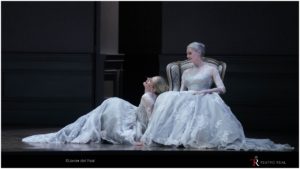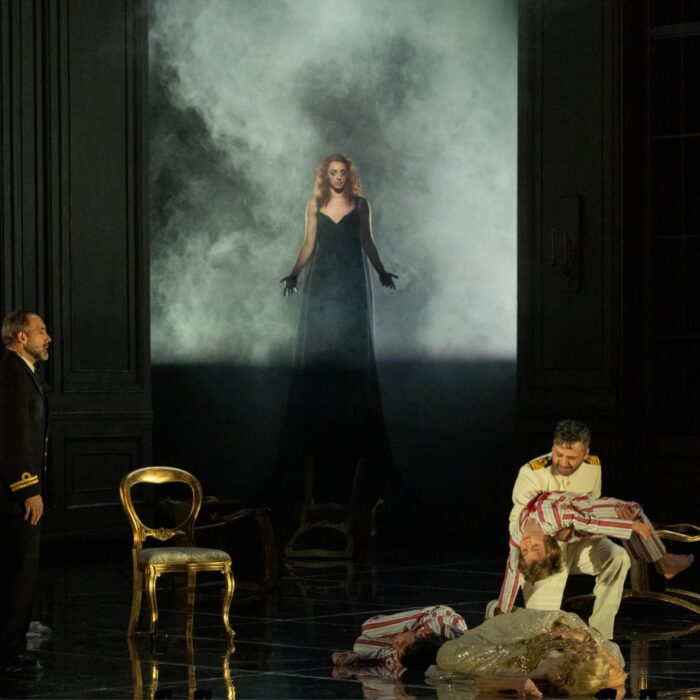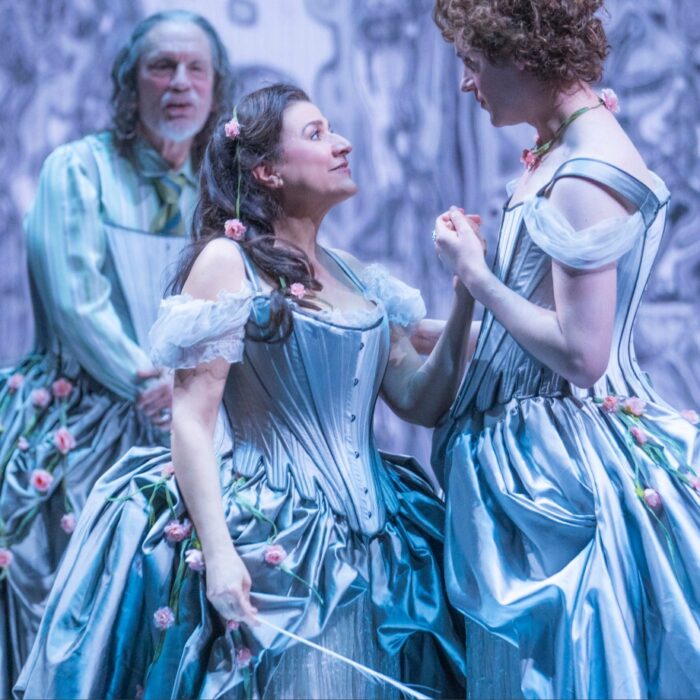
Teatro Real de Madrid Review 2018-19: Capriccio
Malin Byström Shines In Christof Loy’s Vibrant & Energetic Production
By Mauricio VillaIt might not be a coincidence that Teatro Real decided to program the last theatrical composition of Strauss after the last one of Verdi.
“Capriccio” was presented at the Teatro Real for the very first time, in a new production directed by Christof Loy. The performance also featured the debut of Malin Byström (Countess Madeleine), the baritone Josef Wagner (Count), the tenor Norman Reinhardt (Flamand), the baritone André Schuen (Olivier) and the bass Christof Fischesser (La Roche) on their respective roles. It might be surprising with so many artists performing this opera for the first time to find that the result was a perfect theatrical experience, but when there is so much talent and dedication, as was the case, you can only expect a brilliant outcome.
It is a challenging opera as it is often considered too intellectual, the action is very slow with long scenes and dissertations about the world of theatre, and it lasts two and a half hours without intermission. The plot could be summarize in the sentence that Flamand and Olivier discuss on their first scene at the beginning of the opera: What is more important the music or the words? It plays with the idea of “theatre within theatre” as the Countess is in love with two men: Flamand, the composer-music and Olivier, the poet-words and can not decided between them, as there is no resolution regarding the conflict between the weight of music versus words. But the score, even lacking the darkest sinister atmosphere of compositions like “Salome” or “Elektra,” or the jubilant playful tone of “Rosenkavalier” or “Ariadne auf Naxos” by the same author, keeps the fluidity of fragmented melodies that are beautifully intertwined with the spoken quality of the vocal line.
Digging Deep
The brilliant German stage director Christof Loy goes deeper into what could be seen as an intellectual and frivolous libretto to show the complexity of the characters which act in a vast cold empty space presided over by a huge wall mirror hanging above a fireplace. The feeling of coldness, abandonment and decay produced from the sets designed by Raimund Orfeo Voigt is overwhelming. Loy presents a melancholic and tormented Countess, who is not just in debate over the love of two men, but also contending with the passage of time, which is represented by three countesses: a young girl, the widow who is in love with two men, and an old lady. It is a bit ambiguous as to whether all the action is a flashback being remembered by the old countess, or if the action takes place in the present as the countess remembers her past and projects her future life. It ultimately doesn’t matter as it feels the opera has great emotional depth, which is present in the music but not quite so on the libretto.
Loy manages, never going against the music, to create a dynamic show as there is always actions taking place on stage. He uses all the characters throughout the performances, even if they are originally entrusted with small parts. For example, the butler accompanies the countess through the different periods of her life, changing his appearance throughout, even if his singing only comes at the tail-end of the show. The servants participate throughout, constantly the furniture around the stage and creating different spaces. The prompter, Monsieur Taupe, who also has a small intervention towards the end of the opera, enters the stage during the prelude, dropping a sheet of paper on the floor that will have an impact later in the production; this in turn creates a sense of circularity in the action.
Loy also breaks the fourth wall twice by placing the singers in line in front of the stage and having them sing straight to the audience. The first time this happens is during the first big ensemble scene where even the lights in the auditorium turned on half-way. We see this once again during the servants scene.
Also worthy of mention are the dancers: Julia Ibañez y Clara Navarro, as the young countess and dancer; and Elisabeth Macgorian (the veteran ex-principal ballet dancer from the Royal Ballet who still plays character roles with the company), playing the older Countess.
Stunning Debutante
It Is unbelievable that the Swedish soprano Malin Byström was performing the role of the Countess for the very first time.
Not only she was perfect vocally and in style, but her incarnation of the widow was fresh, moving, and sophisticated. She has a dark sonorous voice with a velvety quality. Her German diction is perfect, and her interpretation of her final scene was brilliant. She can be heard perfectly over the orchestra when the sound is densest, but at the same time, she can color her voice to reflect her doubts or sweetness.
Her complicity with all the other characters was also notable. She was constantly interacting and immersed in the world and those. Perhaps the most gripping moments came when she had to witness the confrontation between the past and future incarnations of herself.
She was the absolute triumphant of the evening.
Lovers & More
Christof Fischesser, as La Roche, gave a lesson in how to sing the German repertoire. Being in possession of a flexible dark bass voice, his singing was fluid and easy during the declamatory parts of his long monologue. His high notes ( up to F sharp ) were secure and round, something not easy for heavy voices to manage in such a extreme register. More importantly, his interpretation was measured, giving truth to everything he sang.
The American tenor Norman Reinhardt played the composer Flamand and his voice is transparent and well-toned. He can deal with the high tessitura of the role, but his voice loses brightness and projection when going to his higher register. As a result, the multiple high B flats where difficult to appreciate or non-existent at all as his voice was swallowed by the orchestra or the other singers. In turn, La Roche’s quip that the orchestra should never hide the voices became quite ironic.
André Schuen, a young German baritone, played Olivier. He gave a passionate performance, with his immaculate German diction and sweet lyrical voice. This made him a truly suitable suitor for the countess.
Josef Wagner incarnated the Count with determination and dignity, showcasing some comic chops as he attempted to seduce Clairon without losing the integrity of his noble character. At his side, Theresa Kronthaler played an exotic Clarion, with a slim mezzo-soprano which she handled perfectly, always respecting the indications of the score.
As the two Italian singers, the beauty of the timbre and vocal line of Leonor Bonilla was notable, but the same could not be said for Juan José de León, whose goatist timbre was insecure. That said, de León has a thunderous high C, to which the other character reacted with comic surprise. It seems that he was unable to reach the high C in piano dynamic as is required the second time he reaches the note, so Loy made him sing it while leaving the stage riding his bike, softening the sound.
The characterization of Monsieur Tape by John Graham-Hall was brilliant. Graham-Hall not only performed his short scene with conviction and style but had to act during the first part of the opera with all of his stage craft abilities. Along with Torben Jürgens and the eight servants who demonstrated how to interact, react, and even carry the action throughout the whole performance. In conclusion, this production featured a extremely talented cast under the firm guidance of a meticulous stage director.
Asher Fisher managed to obtain a crystalline sound from the Orchestra of the Teatro Real, always delivering the melodies with clarity, something not easy to accomplish with such a complex score. It is essential to mention the solo interventions from the French Horn, which were of the highest level.
In sum, this was an incredible interpretation of Strauss’ final opera.


